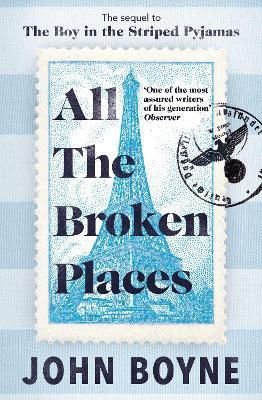All the Broken Places by John Boyne
- NZ Booklovers

- Sep 22, 2022
- 2 min read

Whenever I hold a new John Boyne novel in my hands, I know that there are very good days ahead. All the Broken Places gave my days of reading a resonance, a reminder of how a skilled and assured writer can make a kind of sense of the darkness of our world as well as illuminating our human capacity for kindness, courage and generosity.
This novel is a sequel to The Boy in Striped Pyjamas. When I realized that, I must admit to feeling a little trepidation because that novel left me feeling knocked over for days.
But how could anyone forget Bruno, the little son of the Nazi commandant of the concentration camp where they live, who makes friends with the Jewish boy on the other side of the fence. And how could anyone ever forget that ending?
The setting is present day, London, where Gretel, Bruno’s sister, now in her nineties, is living in an apartment. Gretel does not speak of the past and, apart from the younger woman, Heidi, she regularly has tea with, and occasional visits from her son, her life is one of isolation. When a family moves into the vacant apartment below her, she is confronted by first a violent argument and then her growing realization that the domineering man who lives there is physically and mentally abusing his son and wife. Despite her resistance to becoming involved with others, she becomes close to the boy, who is around the age that Bruno was when he died. She has a choice; either she can help the boy or she can remain silent.
The novel moves effortlessly between past and present; Gretel escaped from Berlin with her mother to Paris, tried immigrating to Australia then, finally, came to England where she married and had a son with her husband, Edgar. At the heart of all of this, though, is Gretel’s fear of exposure as the daughter of a ‘monster’ and the presence of her own guilt. Along with Gretel, we understand and agree that at the time she was a powerless child. However, afterwards shouldn’t she have come forward and borne witness to what happened? But she was so young when the war ended; she was struggling, first of all, with an alcoholic mother and then with her own isolation. Was she wrong to want to try to put the past behind her? Was she wrong to want her own life?
Boyne demonstrates so well the old adage that there are always two sides to a story, that nothing is ever entirely black or white. At the same time, he shows how guilt and shame will remain, dark and festering, preventing the living of a free and full life. At the end of her life, he gives Gretel a choice. She failed to save her brother, but will she save this boy? And will she risk the revelation of her own identity and the exposure of the secrets of her past?
Beautifully written and with wonderful insight and sensitivity, All The Broken Places is a story of compassion, courage and forgiveness.
Paddy Richardson
Penguin Random House



